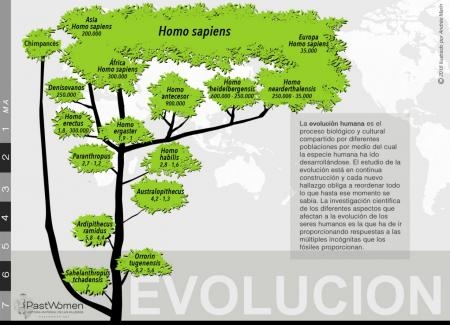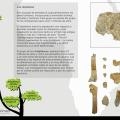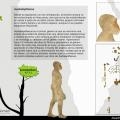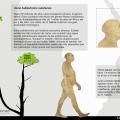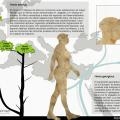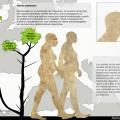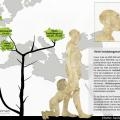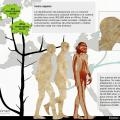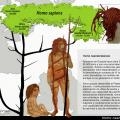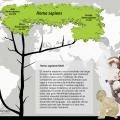Women in...
Human evolution
Human evolution is the biological process by means of which the human species has developed. The study of evolution is under continuous construction and each new find obliges us to reorganise everything we have learned up until then. Scientific research into the different aspects that affect the evolution of human beings must continue to provide answers to the multiple questions that fossils present us with.
Hominids
This is the group of primates that we human beings belong to. The group separated from the chimpanzee group some 7 million years go. The oldest known fossil is called “Toumaï” (Sahelantropus tchadensis) and, together with “Orrorin” (Orrorin tugenensis), which is some 6 million years old, it is the earliest evidence of the origin of bipedalism. They bear no more resemblance to present-day chimpanzees than they do to us.
The Ardipithecus group appeared some 5.8 million years ago and, like their ancestors, they ate fruit and found their food supply both in the forests and on the savanna.
The females of these first ancestors can be differentiated from the males by their size, although it is very difficult to tell the gender of fossil remains without complete skeletons. Researchers believe that Toumaï’s skull suggests the remains of a male and the canines those of a female. However, no particular size differences are documented in the Ardipithecus remains.
Australopithecus
Since it separated from the chimpanzees, the human family has not evolved in straight line, but has subdivided into branches based on a common tree. Many groups coincide at the same time and in the same space, although it is not possible to establish filiations. For example, the Homo genus appeared before the Australopithecus genus had died out, in the same way as anatomically modern humans coexisted for a short time with the Neanderthals.
Australopithecus appeared 4 million years ago in Africa and preceded Homo genus. This group’s best-known remains have been named Lucy and are from a female skeleton found in the Afar Depression (Ethiopia). From the analysis of her teeth we know she had a more varied diet than Homo. The most recent studies have revealed that the first remains of worked stone could have been made by Australopithecus, as they already possessed all the necessary cognitive abilities.
Homo habilis
Some 2.8 million years ago the human species −Homo genus− was born. Homo habilis appeared in Africa 2.4 million years ago and was the first meat-eater. Although there are no objective criteria for distinguishing between the sexes of the fossils, size is usually used: female teeth and skeletons tend to be smaller than those of the male, as is the case with primates. Homo habilis lived until 1.4 million years ago in the south and east of Africa.
Together with Homo habilis, between 2.5 and 2.3 million years ago we see the appearance of Homo rudolfensis, a specialised species different to Homo habilis.
Homo erectus
Around two million years ago, Homo erectus came out of Africa and populated the Middle East, Asia and southern Europe. In Africa they replaced all the Homo species that had existed until the appearance of Homo sapiens some 200,000 years ago. Its first African representatives would be called H. ergaster, as opposed to the Homo erectus that were found in Europe and Asia shortly afterwards. They were bipeds, there are remains of old people and evidence that they were cared for. They were the first to create bifaces, an important innovation in stone working.
Homo georgicus
This is the name given to a newly-discovered species based on fossils dated to between 1.8 and 1.6 million years ago found in Dmanisi, in the Caucasus, Republic of Georgia. This was initially proposed as a separate species between Homo habilis and Homo erectus and linked to Homo ergaster.
Homo antecessor
Appeared at the archaeological site of Atapuerca in the Burgos Mountains (Spain) some 900,000 years ago. Its researchers describe it as a new species different to those known before and it would have evolved from African H. ergaster. Other researchers consider Homo antecessor to be a simple designation referring to the remains found at Atapuerca, which they believe to be Homo heidelbergensis or a variety of Homo erectus/Homo ergaster.
According to an analysis of the microscopic traces left by abrasive food particles in their dental enamel, their diet was based on uncooked hard and abrasive food, such as vegetables with silica particles, tubers with the remains of earth, collagen or connective tissue and bone or raw meat.
Homo heidelbergensis
Appeared more than 600,000 years ago and survived at least until 250,000 years ago. The evolutionary hypothesis is that they may have been the ancestors of both Homo Neanderthalensis and Homo sapiens. Of particular note is their ability for language and the appearance of the first funerary practices at the archaeological site of La Sima de los Huesos (Atapuerca, Burgos).
Homo sapiens
Appeared and came out of Africa 300,000 years ago to eventually populate the whole planet. The current designation is Anatomically Modern Humans (AMH).
Homo Neanderthalensis
Homo Neanderthalensis appeared between 250,000 and 35,000 years ago and would have been a side branch in the evolution with no ancestor-successor relationship to H. sapiens who, according to some research, may have been older. They lived in Europe and the Near East. Cross-breeding between these two species is clearly shown by DNA analyses carried out at some European archaeological sites, although this is not true of the whole of Europe.
These groups developed the Mousterian culture and were responsible for important technological advances in tool manufacture. They also generalised the control and use of fire and produced the first manifestations of symbolic abstraction, as well as the first evidence of burial of the dead and care of the sick.
Homo sapiens/AMH
This is our species and the result of a long evolutionary process that began in Africa some seven million years ago. Walking upright, travelling long distances, an increase in cranial capacity, meat consumption, the ability to adapt, technology and language are the keys that have led us to become what we are today - human beings.
Pictures: Human evolution under construction. Illustrated by Andrés Marín.
